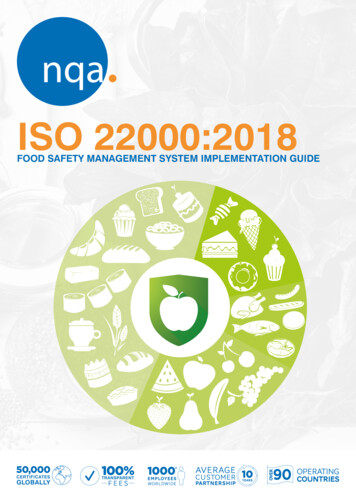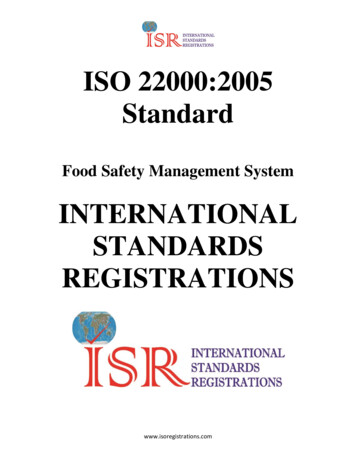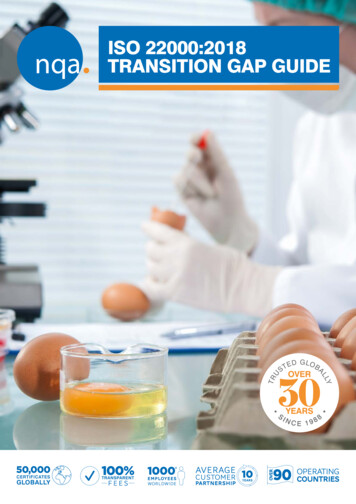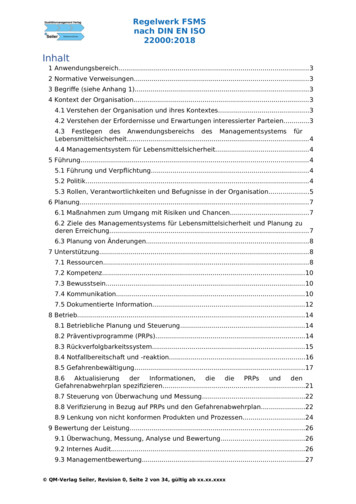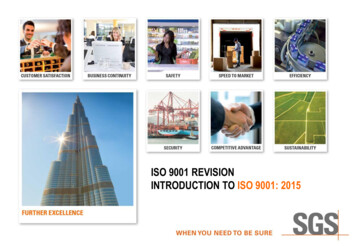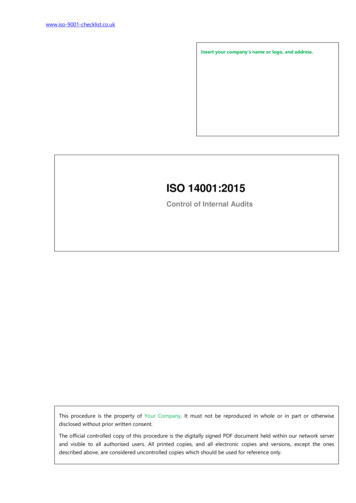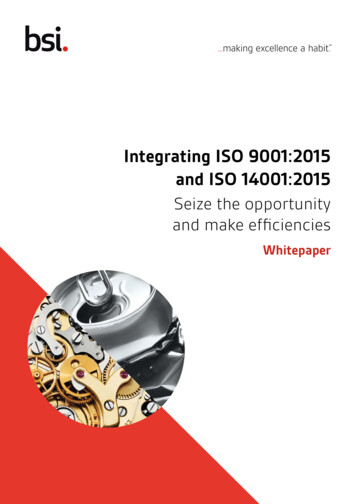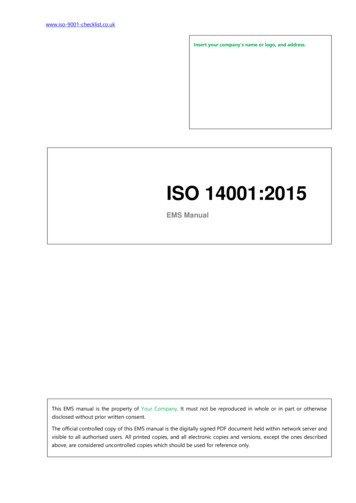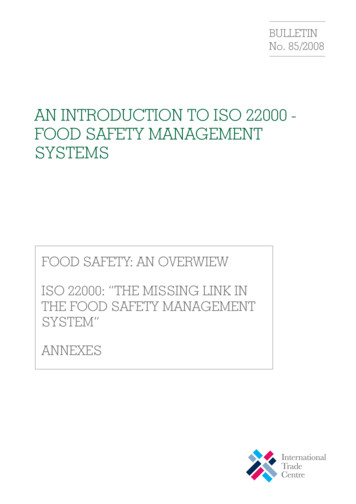
Transcription
BULLETINNo. 85/2008AN INTRODUCTION TO ISO 22000 FOOD SAFETY MANAGEMENTSYSTEMSFOOD SAFETY: AN OVERWIEWISO 22000: “THE MISSING LINK INTHE FOOD SAFETY MANAGEMENTSYSTEM”ANNEXES
This bulletin provides information about food safety, Food Safety Management Systemsand ISO 22000, aiming to help exporters implement such systems.This bulletin has been prepared, without formal editing, by A. Salvi, ITC Intern, under theguidance of S. K. Gujadhur, Senior Adviser on Standards and Quality Management, andin cooperation with L. Ghizzoni, Associate Expert on Standards and QualityManagement, Enterprise Competitiveness Section, Division of Business and InstitutionalSupport, International Trade Centre (ITC). J. Surak, International Consultant on FoodSafety Management Systems, reviewed the bulletin.For more information:Street address: ITC, 54-56 rue de Montbrillant, CH 1202 Geneva, SwitzerlandPostal address: ITC, Palais des Nations, 1211 Geneva 10, SwitzerlandTelephone: 41.22.730.03.96 – Fax 41.22.730.05.76E-mail: quality@intracen.org - Internet: http://web.intracen.org/eqm
iiiAbbreviations and AcronymsBRCBritish Retail ConsortiumCASCOISO Committee on conformity assessmentCCPsCritical Control PointsCDCCentre for Disease Control and PreventionCIESInternational Committee of Food Retail ChainsCodexCodex Alimentarius CommissionFAOFood and Agriculture Organization of the United NationsFSMSFood Safety Management SystemHACCPHazard Analysis and Critical Control PointIFSInternational Food StandardsIPPCInternational Plant Protection ConventionISOInternational Organization for StandardizationITCInternational Trade CentreOIEWorld Organization for Animal HealthPRPsPrerequisite programsSPSSanitary and phytosanitary measuresUNCTADUnited Nations Conference on Trade and DevelopmentUNIDOUnited Nations Industrial Development OrganizationUSUnited StatesWHOWorld Health OrganizationWTOWorld Trade Organization
iv
vTable of contents1.FOOD SAFETY: AN OVERVIEW.11.1 INTRODUCTION .11.1.1 Food safety: an old issue .11.1.2 but a recent challenge.11.1.3 Food safety measures: obstacle to trade or catalyst? .21.2 SPS MEASURES .31.3 HACCP: THE FOOD SAFETY BASICS .31.3.1 Principles.31.3.2 HACCP: The Current Definition of a Food Safety System.51.4 PRIVATE STANDARDS .51.5 FOOD SAFETY MANAGEMENT SYSTEMS .62.ISO 22000: THE “MISSING LINK IN THE FOOD SAFETYMANAGEMENT SYSTEM”.72.1 NEW APPROACH TO FOOD SAFETY MANAGEMENT .72.1.1 Weaknesses of the Previous System .72.1.2 ISO 22000 Family: A Worldwide Basis .82.2 ISO 22000: A NEW GLOBAL FOOD SAFETY STANDARD .82.2.1 Technical Committee ISO/TC 34 “Food Products” .82.2.2 Who is Concerned .92.2.3 Key elements of ISO 22000.92.3 LINK WITH HACCP .112.4 A NEW ELEMENT: TRACEABILITY .142.5 BENEFITS AND COSTS .142.5.1 Benefits for the food industry.142.5.2 Costs .152.6 IMPLEMENTING ISO 22000 .162.7 CERTIFICATION .192.7.1 Principle.192.7.2 ISO/TS 22003.192.7.3 Publicizing the certification .202.8 MARKET FEEDBACK ON ISO 22000.212.8.1 Statistics .212.8.2 Cases of Best Practice .22
vi2.8.3 ISO 22000 and SMEs.232.9 ASSISTANCE FOR A BETTER UNDERSTANDING OF ISO 22000 .232.10 CHALLENGES TO COME FOR THE FOOD INDUSTRY .25AnnexesANNEX I:BEIJING DECLARATION ON FOOD SAFETY .27ANNEX II:THE ISO 22000 FAMILY OF STANDARDS .29ANNEX III : ISO 22000:2005 - CONTENTS .30ANNEX IV:EIGHT KEYS TO AN ISO 22000:2005-BASED FSMS.31ANNEX V:USEFUL WEBSITE LINKS.32
11.FOOD SAFETY: AN OVERVIEW1.1Introduction1.1.1 Food safety: an old issue In 1983, a group of internationally renowned experts convened jointly by theFood and Agriculture Organization of the United Nations (FAO) and the World HealthOrganization (WHO) concluded that “illness due to contaminated food was perhaps themost widespread health problem in the contemporary world,” and “an important cause ofreduced economic productivity.” In 1992, the FAO/WHO-sponsored InternationalConference on Nutrition recognized that hundreds of millions of people suffer fromcommunicable diseases caused by contaminated food and drinking water. TheConference declared, “Access to nutritionally adequate and safe food is a right of eachindividual.” In the same year, the United Nations Conference on Environment andDevelopment recognized that food was a major vehicle for the transmission ofenvironmental contaminants—both chemical and biological—to human populationsthroughout the world and urged countries to take measures to prevent or minimize thesethreats. In 2000, the World Health Assembly, the supreme governing body of WHOadopted unanimously a resolution recognizing food safety as an essential public healthfunction 1 .1.1.2 but a recent challengeFood is a resource of vital importance and its safety in the whole chain, fromproducer to consumer, is a worldwide concern. Indeed, as food trade expandsthroughout the world, food safety has become a shared concern among all consumers.This issue began to be taken seriously at a period where there is a significant increaseof illness caused by infected food in both developed and developing countries. Indeed,Bovine spongiform encephalopathy, foot-and-mouth disease, salmonella highlightedthe risk of food contamination.Unsafe food contains hazardous agents or contaminants that can make peoplesick, immediately or by increasing their risk of chronic disease. Contaminants can enterfood at many different points in the food production process, and can occur naturally oras the result of poor or inadequate production practices 2 .The example of the United States is relevant. Food safety experts insist that theU.S. food supply is one of the safest in the world 3 . However, the Centre for DiseaseControl and Prevention (CDC) estimates that more than 76 million people get sick fromfood related illnesses in the United States each year. This results in more that 300,000hospitalizations and 5,000 deaths. Recently, there have been several high profile foodrecalls in the United States:When spinach was contaminated with a pathogenic strain of E. coli, 199 peoplein 28 states were infected, 141 individuals were hospitalized, 31 individuals developed atype of kidney failure, and three died.1Extract from F.Kaferstein, “Food Safety as a Public Health Issue for Developing Countries” in “Food safetyin food security and food trade” available at Hhttp://www.ifpri.org/2020/focus/focus10/focus10 02.pdfH2See: L.Unnevehr, “Overview” in “Food Safety in Food Security and Food Trade”, International Food PolicyResearch Institute, (September 2003) available atHhttp://www.ifpri.org/2020/focus/focus10/focus10 01.pdfH3Source of this paragraph: John G Surak, “A recipe for Safe Food: ISO 22000 and HACCP”, (October 2007)available at 000/recipe-for-safe-food-iso-22000-andhaccp.htmlH
2When tainted peanut butter turned up on store shelves, 425 people were infectedwith Salmonella, and 71 of them were hospitalized. This contamination produced noknown deaths.The tainted pet food recall involved a long list of both stores and major brandscontaining melamine in product imported from China. The exact number of pet deaths isunknown, but it has been estimated to be more than 20.The cost of a food safety recall is high and accidents can be serious for humanhealth. This has brought claims from customers for more inspectors and moreinspections. Yet, because increasing inspections would be costly and because somenew pathogens are not even identifiable, more inspections do not seem to be a goodoption. It is the effectiveness of inspections that needs to be improved so as to ensurefood quality at every stage of the chain.The increasing public concern about food safety resulted in a High-LevelInternational Forum on Food Safety with the theme "Enhancing Food Safety in a GlobalCommunity", held in Beijing on 26 and 27 November 2007 4 . The forum wascosponsored by WHO, in collaboration with the Chinese Ministry of Health (MOH) andthe State Administration for Quality and Safety Inspection and Quarantine (AQSIS). Theforum brought together senior officials from more than 50 countries and internationalorganizations to review the major issues related to food safety. At the conclusion of theforum, the meeting participants adopted the Beijing Declaration on Food Safety 5 . Thisdeclaration demonstrates the high-level political commitment of Member States toresolving food safety problems through positive collaboration rather than erectinginefficient barriers to trade. It urges all countries to develop comprehensive programmesto improve consumer protection from production to consumption, from routine toemergency, and from domestic to international.1.1.3 Food safety measures: obstacle to trade or catalyst?Indeed, international competitiveness nowadays depends more on quality andsafety concerns than on prices. Governments and local authorities intervene in themarket place in setting technical regulations; and sanitary and phytosanitary measures 6 .Exported products should satisfy these measures as well as additional requirementsdemanded by buyers, such as private standards.The issue about whether or not these measures are barriers to trade arise.Compliance to harmonized international standards is difficult for countries with weakfood safety and quality management capacities. Undoubtedly, as these countries lackthe administrative, technical and scientific capacities to comply with the dynamic andincreasingly strict food safety standards, this represents potentially insurmountablebarriers to their development of international market opportunities. 7There are also accusations that safety measures could be used as protectionisttools, providing ‘scientific’ justifications for prohibiting imports of agricultural and foodproducts, or discriminating against imports by applying higher and/or more rigorousregulatory enforced standards than those applied on domestic suppliers.4Source: Hhttp://www.who.int/foodsafety/fs management/meetings/forum07/en/index.htmlHSee ANNEX 16Information related to these concepts is available at “Export Quality Management – An answer book forsmall and medium-sized exporters”, (2001) International Trade Centre (ITC), p.4 to 77Information in this paragraph is taken from Spencer Henson and Steven Jaffee, “A Strategic Perspectiveon the Impact of Food Safety Standards on Developing Countries”, (August 2006) available p06he13.pdfH5
3However, food safety standards may provide a ‘common language’ throughincreasingly global supply chains in a manner that diminishes reducing transaction costs.It also promotes consumer confidence in food product safety, without which the marketfor these products cannot be maintained and/or enhanced 8 .International standards related to sanitary and phytosanitary measures (SPS) areestablished by three international bodies (see below).1.2SPS Measures 9When the safeguard of human, animal or plant life and health is invoked, acountry can set a standard. This rule is provided by the World Trade Organization(WTO) Agreement on the Application of Sanitary and Phytosanitary Measures (SPS) 10 .This Agreement includes all the requirements directly related to food safety and animaland plant health. Sanitary measures deal with human or animal health, andphytosanitary measures are related to plant health.The SPS Agreement recognizes three main international standard-setting bodies,which are the official entities for developing health-related standards, guidelines andrecommendations. These are:The Codex Alimentarius Commission (Codex) 11 , which is the key internationalstandard-setting body for f
ISO 22000: “THE MISSING LINK IN THE FOOD SAFETY MANAGEMENT SYSTEM” ANNEXES AN INTRODUCTION TO ISO 22000 - FOOD SAFETY MANAGEMENT SYSTEMS. This bulletin provides information about food safety, Food Safety Management Systems . and ISO 22000, aiming to help exporters implement such systems. This bulletin has been prepared, without formal editing, by A.

